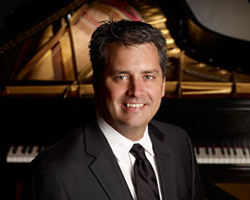by Daniel Hathaway

On Friday evening, September 5, Cassidy returned to the area to play a solo recital at First Unitarian Church of Cleveland in Shaker Heights, enroute to solo appearances at the Church of St. Mary The Virgin in New York and the Peterskirche in Vienna. His local performance boded well for his subsequent recitals. He presented a thoughtful, well-balanced program, playing with elegance and a keen sense of style.
Cassidy began with a compelling reading of a striking contemporary work, David Noon’s Elegy Variations, a six-minute piece that fills its brief space with rapidly-contrasting moods from the elegiac and nostalgic to the angry.
Mozart’s Viennese publisher, Artaria, bundled his Fantasie in c minor, K. 475 with the Sonata in c minor, K. 457 and brought them out in December of 1785 as the composer’s Opus 11. Cassidy also bundled the two pieces together on his recital, allowing K. 475 to flow directly into the first movement of the sonata. It was a plan that worked. Cassidy played the Fantasie in an improvisatory style and brought out the drama and pathos in the Sonata, mining the depths of two works that represent unusual excursions by Mozart into a minor key.
After a brief intermission, Cassidy offered nicely inflected performances of the first six Préludes of Debussy’s Book II, short works that vividly paint impressionistic scenes or concepts: Brouillards (Mists); Feuilles mortes (Dead Leaves); La puerta del Vino (the Wine Port); “Les fées sont d’exquises danseuses (“Fairies are exquisite dancers”); Bruyères (a French town); and Général Lavine — eccentric. Cassidy expertly brought out the individual character of each vignette, which bear such performing instructions as “Slow and melancholy,” “Light and rapid,” or “Calm,” and underlined characteristic dance rhythms in the Wine Port’s Habanera and the General’s Cakewalk.
He concluded the evening with well-voiced and idiomatic performances of the three intermezzos and rhapsodie from Brahms’s Vier Klavierstücke, op. 119.
Conditions were not ideal. The evening was hot and muggy, and the church is not climate-controlled (ushers passed out “personal air conditioners” which kept the audience busy fanning themselves as quietly as possible, a solution unavailable to the soloist, whose hands were otherwise occupied).
Then came the distraction of a mini-explosion midway through the second work on the program: a tire blew out on a wheelchair in the front row with all the drama of a gunshot. Cassidy stopped in mid-bar, inquired whether the occupant was OK (she was) and calmly resumed after she sweetly inquired if he could “back up a little.”
Such are the vagaries of performing in church sanctuaries and Cassidy gets extra points for rising well above those circumstances on Friday evening. The audience agreed, put down their fans, and gave the pianist a spirited ovation. The recitalist responded with an affectionate, lyrical performance of the second Intermezzo from Brahms’s op. 118.
Published on ClevelandClassical.com September 15, 2014.
Click here for a printable copy of this article.


